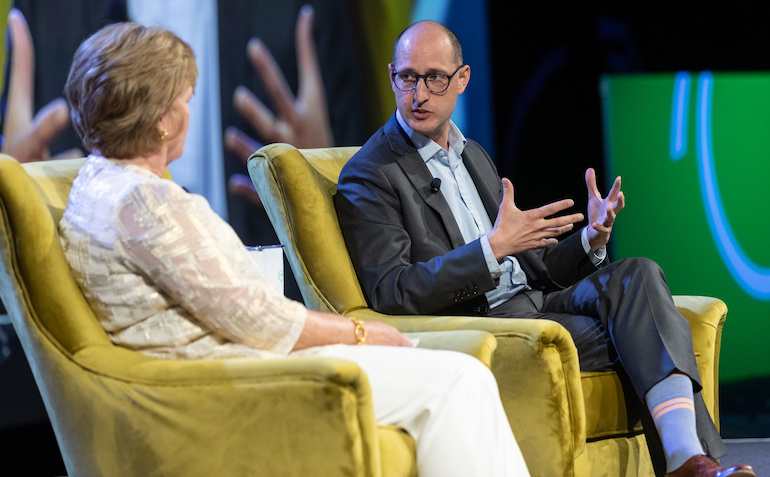Leslie Sarasin has served as president and CEO of FMI-The Food Industry Association, formerly the Food Marketing Institute, since 2008. In early March, she was named as the 2021 Association CEO of the Year by CEO Update, an annual recognition given to the outstanding trade association chief executive officer.
Earlier this week, FMI held its Midwinter Executive Conference, the association’s annual meeting for top grocery industry executives, in person for the first time in two years. In a post-conference interview today with Supermarket News Senior Editor Russell Redman, Sarasin talked about the return of the in-person Midwinter event and gave her takes on the current economic climate and grocery industry trends. Here are edited excerpts of the discussion.
SUPERMARKET NEWS: What was it like to reconvene the FMI Midwinter Executive Conference? It has been over two years, right?
LESLIE SARASIN: That is correct. The last time we were together for Midwinter was January of 2020, and we were very fortunate that Midwinter comes early in the year. So we were able to get a 2020 event in before the country shut down. But [this year] it was such a tremendous feeling to have everybody together again. I had noted to our team on several occasions how the energy felt. I think everybody was just so pleased to have the chance to see each other, finally, in some manner other than on a computer screen and be able to connect as we all do in this industry. We are, as you know, a very social group. The last two years have been tremendously difficult, because we’re accustomed to being together frequently. So having a two-year stint where we didn’t see each other at all just made being together this week that much sweeter.
SN: Yes, it was palpable among attendees throughout the conference that everyone was just glad to be together in person once again.
SARASIN: I agree. I thought the energy was so high and people seemed genuinely happy to be out of their homes or their offices — or wherever they’ve been working for the last two years — and be back in a social setting and be able to have the one-on-one business meetings. It really has made a difference in how people are feeling about their businesses today and their businesses going forward.
SN: Back to what’s going on in the industry, how are grocery retailers and consumers faring in the current volatile economic climate?
SARASIN: As you know all too well, the ongoing supply-chain challenges as a result of the pandemic and now the war in Ukraine are having significant impacts on how the food industry is operating. We’re in some ways not unique in that regard, because every industry in the U.S. economy is having to deal with change. But what we’re seeing are worker shortages driven by a host of factors. Our people are dealing with child care responsibilities that are new and different than pre-pandemic. They continue to have, from the data we’ve shown, health concerns. And then we’re having difficulty recruiting and retaining workers in the food industry, but also more broadly throughout the economy. So those are creating challenges for food retailers and our supplier partners as well.
We have supply chain disruptions that started during the pandemic, most recently during the Omicron time period [of COVID-19]. So we’re continuing to have those issues work their way through the system. Sometimes it takes months before these results are actually felt at store-level, but our retail members are having to stay really nimble in the face of these challenges. It has been described as sort of whack-a-mole from one week to the next in terms of the changes in which products are affected. This week, it might be an issue on the East Coast, and next week it might be on the West Coast and be a totally different product challenge. So we have to be terribly vigilant to make sure we’re aware of what is coming and how we can best deal with it. Sometimes, it’s not just the product itself that’s not available, but perhaps the packaging is not available. So it’s a constant vigilance challenge.

At the Midwinter conference, Sarasin and FTC Commissioner Noah Phillips discussed competition and regulation in the current grocery marketplace.
Then, of course, there’s the situation in Ukraine, where we’re having challenges that could drive prices for raw and finished materials. It’s even higher at a time when we already are experiencing inflation here in this country. We know that Russia is the world’s largest exporter of wheat and a major food supplier to Europe. We also know that Ukraine is considered the bread basket of Europe. So when you add those two factors together — they account for about 29% of the global wheat export market — that’s significant. When the cost of raw materials like wheat goes up, then the price of the products that they're used to make also go up.
We’re talking about staples like bread and pasta, and even beer. We are having similar issues when we think about edible oils. Ukraine is the world’s largest exporter of sunflower seed oil, and that is a key component of the world’s vegetable oil supply. These are just a couple of examples of things that we’re dealing with in the global supply chain as a result of the Ukraine conflict. There’s no silver bullet tha’s going to address these challenges. So we’re fortunate that our retail supplier members are a very resilient bunch. I think that, together, they will continue to work closely to try to find a way to offset these impacts as much as they can and at the same time try to keep prices as low as possible.
SN: As you’ve touched on, shoppers continue to report out-of-stocks across grocery store categories, reflecting lingering supply-chain disruptions and labor shortages from the pandemic. How are retailers and suppliers able to address this?
SARASIN: Out-of-stocks are something that retailers hate. These are challenges for grocery stores all the time. They’re particularly very difficult to predict right now because they’re inconsistent and can be regional. The good news is that there has always been plenty of food in the U.S. system. Even in the early days of the pandemic, there was never any question that there was enough food available. The issue was exactly what food is going to be available on which days, right? The challenges that we have seen have really been supply chain issues and difficulty in getting products to the store and on the shelves in a timely manner.
The other good news is that the out-of-stocks we’ve seen have been generally short-term. It has not been a situation in the vast majority of cases where product was not on the shelf at all for days on end. So we’ve been fortunate in a lot of ways. And retailers have been trying to support their shoppers by giving them suggestions on ways to plan meals, stretch their budgets further, and recommending different meals, recipes and ingredients that they might be able to use as a substitute. Many of our retailers have registered dietitians and nutritionists on site in their stores, right? And part of the role that those individuals can play is to help guide customers in identifying some of the product substitutions they can consider that will also align with their health goals and dietary restrictions. What we are recommending is that consumers check with their local retailer to see if those services are being offered and how they can maximize them for their own benefit.

Sarasin with FMI Chairman and Hy-Vee Chairman, President and CEO Randy Edeker on stage at the PepsiCo Rooftop Block Party on the first day of Midwinter.
SN: On the plus side for grocers, the food-at-home trend is lasting longer than many industry executives expected, even with consumers returning to restaurants. What’s driving that, and what’s your outlook for this trend?
SARASIN: The pandemic was the big initial driver for this shift to eating at home. As we know, restaurants closed and people had to eat more at home than they had pre-pandemic. What we’ve found in our research is that, over the course of the pandemic, Americans have really come to enjoy the additional time they have at home with their families to have meals together. So my sense is that, even as foodservice opportunities open back up, Americans are going to be reluctant to give back all of that family time that they’ve looked forward to every day. Now of course, people will return to dining out to some degree. But our research shows that people continue to view grocery shopping as less risky than dining out from a COVID-19 perspective. I think that’s going to be important.
Our retailers also have done a great job of innovating to give consumers a restaurant-like experience at home through some of the things they’re offering in stores, with ready-made meals, meal kits and opportunities for people to enjoy a quality meal at home in a convenient way, even as they return to work and don’t have as much time to do their own cooking. I think the food-at-home trend is here to stay for the foreseeable future. As the economy continues in the situation we’re in right now, people may want to eat out more, but the data I’ve seen indicate that the foodservice price increase has been even higher than that of the [grocery] retail sector. So, economically, it’s going to be more challenging for people to make a lot of changes in what they’re doing by eating at home.
SN: How has the typical shopping basket changed in the wake of the pandemic? Are the current high food prices changing it further?
SARASIN: It has been interesting to watch we. Early on in the pandemic, we started monitoring what consumers were doing and really tracking week to week how things were changing. We’ve continued to do that, not quite as frequently as early on, but what we have seen is that throughout the pandemic shoppers were incredibly resilient in their response to the shifting circumstances of what was going on in their grocery store aisles. Weekly spending increased sharply when the pandemic started, and a lot of that was attributed to some of the panic-buying that was going on. As people calmed and realized there will continue to be food on the shelf, that weekly shopping spend has come down significantly and remained relatively stable since last summer. I think that has been a credit to the industry, especially when we consider some of the shocks to the food system that have happened in the meantime, with the Delta and Omicron [COVID] variants.
Much more recently, the weekly spend numbers have inched up. Overall, our last research shows that we continue to have strong consumer demand for food and household goods. I don’t have any specifics on the typical baskets and what’s in there. But usually, in periods of high inflation, we see shoppers gravitate toward items that offer more bang for the buck, which tend to be dry goods like rice and beans or things like buying chicken thighs instead of chicken breasts. And of course, there’s always the option of store brands. These products offer quality and, many times, a lower price than the national brands and have been an option that many of our customers are taking advantage of. I think we’ll see shoppers continuing to make these kinds of decisions if inflation continues to persist, as the experts seem to be predicting will be the case for the rest of the year.

Sarasin delivers her morning keynote address on the third day of the Midwinter conference.
SN: How well have grocery retailers met the rapid upsurge in demand for online grocery services? And as we pass year two of the pandemic, has this driven further digital transformation in other parts of their businesses?
SARASIN: The answer is yes. Food retailers have done an incredible job, in my estimation, throughout the pandemic. Just think about what they did and how quickly they did it in changing their online shopping offerings to consumers. When we worked together in January of 2020 at [FMI] Midwinter, we talked about what our projections were for the growth of online over the next five or six years. What we found is that once the pandemic came on, what we had projected would happen over the next five or six years began to take place over five to six months. So it was incredible how quickly the industry responded. With restaurants and other foodservice operations like cafeterias shutting down almost overnight, retailers really had to step up to the plate to make sure that their customers were able to get the food they needed to feed their families.
What we’ve seen after two years of the pandemic is that our customers have really taken to shopping online. It’s interesting what happened given how much concern and hand-wringing went on pre-pandemic about whether consumers would actually want to have store associates pick certain items for them. I mean, I was the poster child for this. I could not imagine ever wanting someone else to pick my tomatoes. But you know what, I adapted. I was very happy with the pickings they did. And I think that, in the consensus throughout the consuming public, what we’ve seen in the last few months is that the number and the frequency of online trips has plateaued to some degree. Even so, it has remained so much elevated from pre-pandemic levels.
I think we have to acknowledge that this is with us for the future. If we think about the convenience factor of having these products delivered to your door or placed in your car when you drive up out front, we’ve all gotten used to it. And even though we may not use that option for every shopping trip, we will continue to use it on occasion, particularly when we need convenience. The beauty of it, in a lot of ways, is that there are so many different ways to do online shopping. Retailers have done a really good job of tailoring their approach to online shopping and deliveries to the best fit the customers they serve, whether that’s click-and-collect, curbside pickup or same-day delivery to your home, or even standard shipping of grocery items. There’s something for everyone.
The further exacerbation of this has been the growing ways that retailers have leveraged data to better adapt their inventory, to meet customers’ needs. The amazing growth in amount of data they have now as compared to what they had pre-pandemic — when they already thought they had quite a bit — has led companies to do things like hire more data analysts and more technologists and then study the data and figure out ways to further tailor the online experience. We see, in some markets, robotics professionals are being hired by grocers to help them understand and better incorporate automation into their inventory processes and even management of in-store operations. So I think this digitalization of grocery shopping has had significant, positive effects, both on the broader industry and on the consumer shopping experience.





